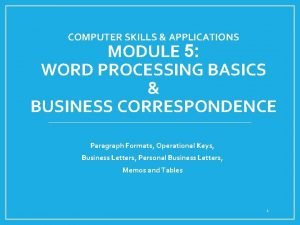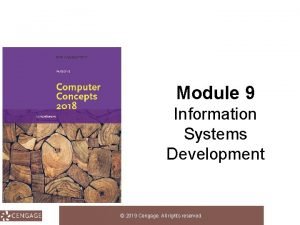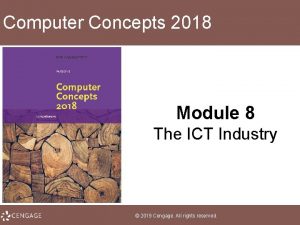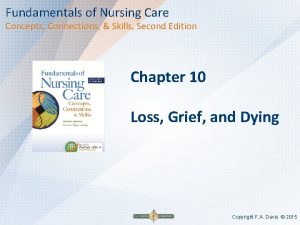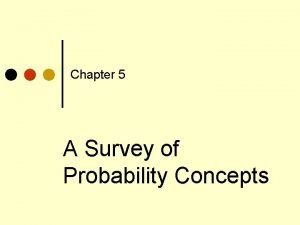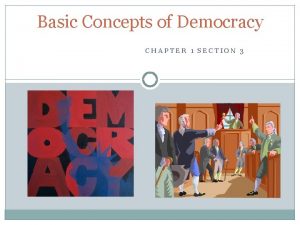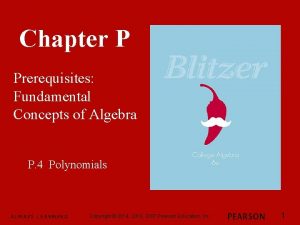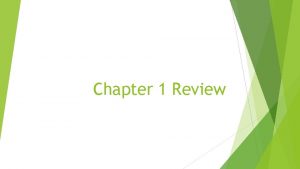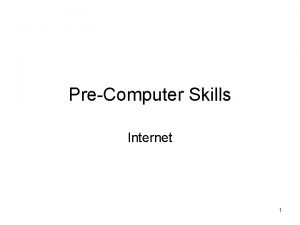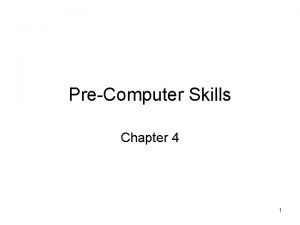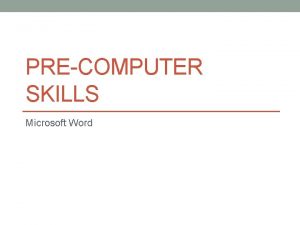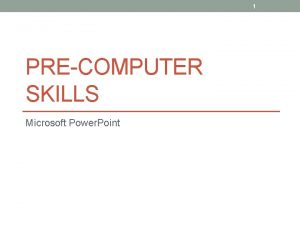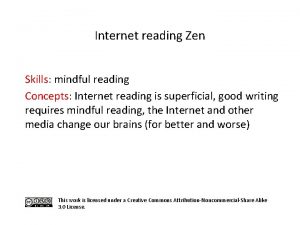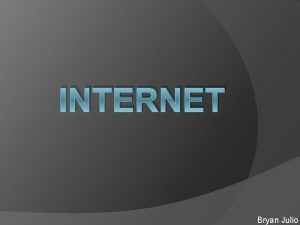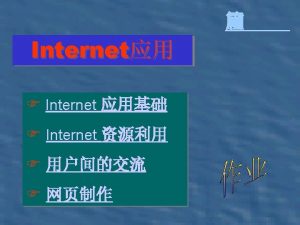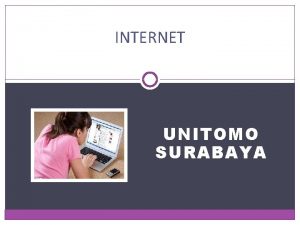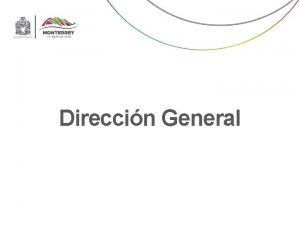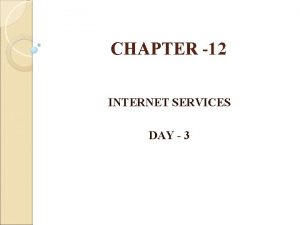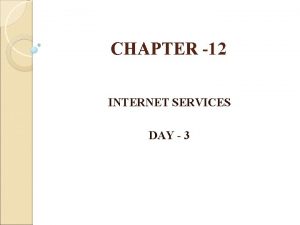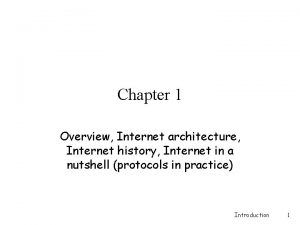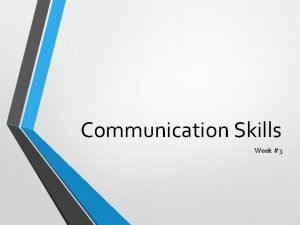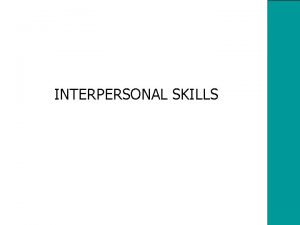PreComputer Skills Chapter 4 1 General Concepts Internet
































- Slides: 32

Pre-Computer Skills Chapter 4 1

General Concepts • Internet A system of connected computers that allows your computer to exchange data, messages and files with any of the millions of other connected computers. • World Wide Web (www) A collection of Web pages and related resources which are linked together across the Internet 2

General Concepts • Intranet A private network that is contained within an enterprise, and used to share company information among employees. • Extranet A private network that uses Internet technology to share part of business information with suppliers, partners, customers or other businesses. 3

General Concepts • Hyperlink A piece of text that can perform an action when the users clicks on it. • Web Browsers Are computer programs that allow people to access information on the World Wide Web (WWW), e. g. Microsoft Internet Explorer and Netscape Navigator 4

General Concepts • Web Site A computer storage area that contains one or more Web pages. • Home Page The first Web page you see when you launch Internet Explorer. • Uniform Resource Location (URL) A unique address given to every web page 5

General Concepts • Protocol between computers over the network • Site Map or Site Index is similar to a table of contents in a book; it tells you where you can find information by category. • Internet Service Provider (ISP) A company that offers their customers access to the Internet 6

General Concepts • Hyper Text Markup Language (HTML) A set of formatting commands that you place around a text or pictures to create a Web page. 7

General Concepts • Web Address: Domain Name Country Code http: //www. philadelphia. edu. jo Protocol Type World Wide Web Top Level Domain 8

General Concepts • Domain names: –. com –. org –. net –. gov –. mil –. edu 9

Internet Connection Services There are different Internet connection services, such as: • Dial-UP Connection: – Early days of the Internet – Computer Modem Phone Line – To connect, user should dial up the ISP. – Disadvantages: • Very slow • To make a phone call, you should disconnect the Internet. 10

Internet Connection Services • Broad. Band Connection: – Permanent connection to the internet – No need to disconnect to make a phone call – Immediate access to your email – Fast service – Paid on monthly basis, not by seconds. 11

Options for Internet Connection • Phone Line – Most common option – Uses your phone line for connection – It needs a computer, a modem, a phone and an account with an ISP. • The mobile phone – – Wireless Technology Uses the existing cellular telephone networks Available anywhere there is a cellular coverage Portable and perfect for traveling 12

Options for Internet Connection • Satellite – – Delivers the Internet via satellite dish Speed quite high Requires special equipment High cost • Wireless Hot Spots – Wireless and high speed Internet connections – Often provided in airports, hotels, cafes, shopping centers and restaurants – Free for web browsing, but no downloading permitted. 13

Characteristics of Broad. Band • Fast connection to the Internet – Rapid loading of web pages – Fast downloading of files and attachments – Ability to talk to others (audio and video chatting) and attend video conferences at real time • An Always-On connection – Available 24 hours 14

Characteristics of Broad. Band • Flat Fee Payment – Cost depends on the speed of the service you require, and the amount of downloads and uploads • Risk of Intruder Attack – Your computer is in constant contact, which enable hackers to invade your computer connection – Anti-virus programs should be up-to-date – Firewalls are need to prevent unauthorized external users from accessing the system. 15

Security Consideration • Identification ( )ﺗﺤﺪﻳﺪ ﻫﻮﻳﺔ ﺍﻟﻤﺴﺘﺨﺪﻡ – A User ID is used to logon to a computer or a computer network. It uniquely identifies you to the network • Authorization ( ﺍﻟﺘﻮﺛﻴﻖ - )ﺍﺛﺒﺎﺕ ﻫﻮﻳﺔ ﺍﻟﻤﺴﺘﺨﺪﻡ – A proof that the user is authorized, either a signature or a password. • Authentication ( ﺍﻟﺘﻔﻮﻳﺾ - )ﺗﺤﺪﻳﺪ ﺻﻼﺣﻴﺎﺕ ﺍﻟﻤﺴﺘﺨﺪﻡ – Specifies the privileges given to users to access certain resources or data. 16

Security Considerations – Password Policies • Passwords: are secret words or numbers that must be keyed into a computer system to gain access. • To make a password more effective: – Do not share it with others – Change it regularly – Choose your password from a combination of letters and numbers that are difficult to be guessed by others. 17

Security Considerations Data Security • Data Security: is a system of safeguards for protecting information technology against disasters, system failure, or unauthorized access that can result in damage or loss. 18

Security Considerations Backups • They are copies of all software, files and information which you have in your computer systems. You can use those copies when the original copies are damaged because of physical failure, user errors, accidents or carelessness. 19

Security Considerations Firewall • A Firewall, is a set of related programs located at a network server that protects the resources of a private network from users from other networks 20

Security Considerations Viruses • Viruses are software programs which are written with the intention of causing inconvenience and disruption or serious damage in a computer system. Files on floppies can spread viruses across a network or via email and the internet. • There are several types of viruses, some targets specific types of files, others targets the main memory, and others effect the booting of the computer system. 21

Security threats from websites • • • Malware. Spyware. Fraud. Spam. Pop-up blocking 22

Security Considerations How can Viruses enter a computer system • Viruses hide on disks. When you access the disk, the virus will infect your computer. It then can spread from one computer to another. When you connect to Internet, you have to make sure that Anti. Virus programs are working and are updated. 23

Security Considerations Indicators of Virus infection • There are some indicators that show you that your computer might be infected by a virus, such as: – When it runs slower than normal – When it crashes and restarts every few minutes – It restarts on its own and then fails to run normally – When you see unusual error messages 24

Security Considerations Protection against viruses • To protect your computer against viruses, do the following: – Use a high-quality anti-virus program such as (Norton and Mc. Afee), and be sure to update it regularly – Always scan your disks and files after using them on other computers – Always scan the files you download from the Internet. The same applies to attachments downloaded from e-mails – Make back-up copies of important documents or files and store them on separate disk 25

Security Considerations Illegal Access • Illegal access to the computer information includes copying, modification and locking of the data on the single computer, computer systems and networks. The main object of the illegal access to the computer information is reaching the owner’s information and invading his or her privacy right. 26

Security Considerations Illegal Access • Illegal access may cause the following: – The web site is deleted, modified or corrupted – Corporate networks will end up experiencing virus attacks – You will receive email threats – Your mail will become available to an unauthorized party – Others will own your private information – Modifications or corruption of the databases and documents 27

Security Considerations Hacking • Hackers are people who create or improve programs and share them with fellow hackers to gain unauthorized access to computer systems. 28

Security Considerations Password Cracker • Password Cracking: is the process of recovering passwords from data that has been stored in a computer system. • A common approach is to repeatedly try to guess the password. • The purpose of password cracking: – Help a user recover a forgotten password – Gain unauthorized access to a system – Check for easily cracked passwords (Used by administrators) 29

Security Considerations Encryption and Decryption • Encryption: is the conversion of data into a form that cannot be easily understood by unauthorized people. • Decryption: is the process of converting encrypted data back into its original form, so it can be understood. In order to do that, a correct decryption key is required. 30

Parental Control options • • Supervision. Computer usage time limits. Computer games restrictions. Web browsing restrictions. 31

Secure & unsecure websites • Using Secure Socket layer (SSL) technology. • The URL starts with https: // 32
 Sf4o lewis structure
Sf4o lewis structure Word processing packages
Word processing packages Module 7 computer concepts skills training
Module 7 computer concepts skills training Module 8 computer concepts skills training
Module 8 computer concepts skills training History curriculum victoria
History curriculum victoria Fundamentals of nursing care concepts connections & skills
Fundamentals of nursing care concepts connections & skills What is internet
What is internet Intrapersonal skills definition
Intrapersonal skills definition Hard skills
Hard skills Skills passport
Skills passport Planos en cinematografia
Planos en cinematografia Where did general lee surrender to general grant?
Where did general lee surrender to general grant? Chapter 17 promotional concepts and strategies answer key
Chapter 17 promotional concepts and strategies answer key Chapter 33 entrepreneurial concepts answers
Chapter 33 entrepreneurial concepts answers Chapter 15 developing fraction concepts
Chapter 15 developing fraction concepts A survey of probability concepts
A survey of probability concepts Promotional concepts and strategies
Promotional concepts and strategies Chapter 1 section 3 basic concepts of democracy
Chapter 1 section 3 basic concepts of democracy Prerequisites fundamental concepts of algebra
Prerequisites fundamental concepts of algebra Chapter p prerequisites fundamental concepts of algebra
Chapter p prerequisites fundamental concepts of algebra Chapter p prerequisites fundamental concepts of algebra
Chapter p prerequisites fundamental concepts of algebra Chapter 2 analyzing transactions answer key
Chapter 2 analyzing transactions answer key Reviewing concepts and vocabulary chapter 1
Reviewing concepts and vocabulary chapter 1 Chapter 1 activity basic concepts
Chapter 1 activity basic concepts Chapter 11 basic concepts street law
Chapter 11 basic concepts street law Chapter 7 organizational behavior
Chapter 7 organizational behavior Chapter r basic concepts of algebra answers
Chapter r basic concepts of algebra answers Operating system concepts chapter 8 solutions
Operating system concepts chapter 8 solutions Operating system concepts chapter 5 solutions
Operating system concepts chapter 5 solutions Operating system concepts chapter 5 solutions
Operating system concepts chapter 5 solutions Chapter 4 accounting study guide
Chapter 4 accounting study guide Chapter 2 basic concepts and proofs answers
Chapter 2 basic concepts and proofs answers Basic marketing concepts
Basic marketing concepts

